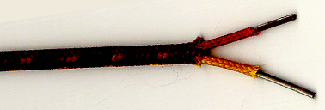A HOLISTIC APPROACH & STRATEGIC VISION FOR PROCESS SOLUTIONS
FIBERGLASS BRAIDED
Fiberglass Braided Sensor Wire is designed to withstand extreme temperatures while offering excellent mechanical strength. The braided fiberglass insulation provides superior heat resistance and durability, making it ideal for high-temperature industrial environments. This wire ensures reliable performance in challenging applications like thermocouples, heating elements, and temperature monitoring systems
Example Applications: Heat Treating, Glass & Ceramic Kilns, Foundries, Extensive applications in aluminum processing, Preheating & Stress Relieving of Forgings, Heat Treating for annealing, aging, or hardening, Homogenizing furnaces for billet preheating, Furnace Temperature Surveys
Symbols:
‡ = All fiberglass is impregnated with a high-temperaure resin to increase durability and reduce fraying.
GG: Most popular and widely applied of all glass insulations. A color-coded fiberglass braid saturated with a high-performance resin is used for insulation of the single conductors and jacket.
| Compounds | Shields /Twisting | Temp. Rating | Notes |
|
Singles: Fiberglass ‡ Jacket: Fiberglass ‡ |
None |
Continuous: 480°C
Intermittent: 540°C (1200°F) |
Comparison to Other Constructions:
Abrasion Resistance – Fair
Chemical Resistance – Fair
Moisture Resistance – Fair
Relative Cost – Low
STW: A high temperature, high tensile strength, extra heavy fiberglass yarn is braided over each conductor. The insulated, color-coded conductors are impregnated with a high-temperature modified resin and twisted to form a pair. This product construction does not include an overall jacket.
| Compounds | Shields /Twisting | Temp. Rating | Notes |
|
Singles: Hi-Temp “S”-glass ‡ No Jacket |
No Shields Singles Twisted |
Continuous: 650°C
Intermittent: 790°C (1650°F) |
Comparison to Other Constructions:
Abrasion Resistance – Fair
Chemical Resistance – Fair
Moisture Resistance – Fair
Relative Cost – Low
HGHG: A high-temperature, high tensile strength fiberglass, either color-coded or with tracer yarn, is braided on both the single conductors and the overall jacket. Both are impregnated with a 500ºF modified resin saturant .
| Compounds | Shields /Twisting | Temp. Rating | Notes |
|
Singles: Hi-Temp ‘glass ‡ Jacket: Hi-Temp ‘glass ‡ |
None |
Continuous: 650°C
Intermittent: 790°C (1650°F) |
Comparison to Other Constructions:
Abrasion Resistance – Fair
Chemical Resistance – Fair
Moisture Resistance – Fair
Relative Cost – Medium
Mineral Insulated (MGO) Sensors
Industrial Thermocouples
Plastics & Packaging
Temperature Transmitters
Resistance Temperature Detectors
Thermowells
Custom Designed sensor




